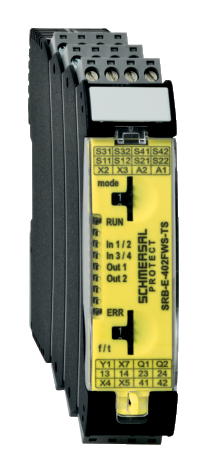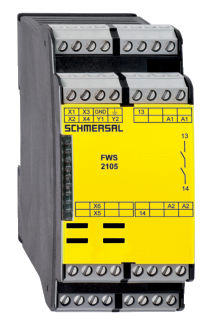Standstill monitors and time relays

Multifunctional
- Detects standstill using 1 or 2 impulse sensors
- additional standstill signal, e.g. PLC as second input channel
- 2-channel time monitoring
- 2 Signalling outputs
FWS AND AWR
FAIL-SAFE STANDSTILL MONITORS
Series AZR 31 S1 and FWS fail-safe standstill monitors are used to capture machinery standstill and to control connected solenoid interlocks. With series AZR 31 S1, it is possible to build protective devices that achieve category 4, PL e in accordance with ISO 13849-1, depending on the external wiring in connection with a safety relay module.STRUCTURE AND MODE OF OPERATION OF THE SAFE STANDSTILL MONITORS
The standstill monitors have an internally redundant design and are equipped with two safety relays with monitored forcibly guided contacts. The series-connected interfaces of the relays act as output contacts. The solenoid interlocks can only be activated and the safety guards opened when the respective machine has come to a standstill. This is done via the output contacts of the standstill monitors.AZR 31 S1 AND FWS SIDE BY SIDE
The AZR 31 S1 standstill monitor is sensorless and is connected directly to a three-phase AC motor. In this way, it measures the frequency of the induced voltage. The enable fields close when the motor is at a standstill. LEDs are used to display the various operating states. The standstill monitors of the FWS series evaluate pulses generated by rotary movements. These can come from incremental encoders or inductive proximity switches, for example. The enable paths close as soon as the detected pulse sequence falls below the limit frequency. Fail-safe standstill monitors are equipped with integrated system diagnosis for rapid and simple fault detection. Users receive information about the switching status of the standstill monitor and the connected pulse generators via the multifunction LED. The Schmersal Group provides detailed product descriptions of the safe standstill monitors in its comprehensive online catalogue under the category ‘Safe signal processing’.Safe time relay SRB-E
The safe time relays of the SRB-E series are designed for the safe measurement of a preset time. The control system only gives the go-ahead after an individually adjusted period of time has elapsed. This enables, for example, the opening of a specific protective device. The time relays of this series are often used in situations where dangerous situations may arise after a system or machine has been switched off. This may be the case, for example, with overrun movements. Depending on how the external wiring is connected to an SRB-E series safety module, requirements can be achieved that reach up to category 3 according to EN ISO 13849-1.
Safe timing relay: design and function
The AZS safety monitoring module has a redundant design. Each of the two channels contains a safety relay and a microprocessor with coding switches for setting the time. The release paths are formed by the series-connected normally open contacts of the two safety relays. The two short-circuit-proof additional transistor outputs can be used for signalling purposes. When the motor contactors drop out, the inputs of the timing relay are activated and the set time is started. When this has elapsed, the release is granted and the coil of the AZM series safety interlock is activated. The guard can then be reopened. The AZS timing relays also feature an integrated system diagnostics (ISD) to ensure quick and easy fault detection. The time relays are also available with different operating voltages.
Safety relay modules from the Schmersal Group
The Schmersal Group's extensive online catalogue provides detailed information on safe time relays, standstill monitors and a range of other products in the field of safe signal processing. The company has been developing and manufacturing safety systems in this field for decades, based on the principle of ‘systematic safety’.
.png?id=bb44e9061d048e5250879d3fc4285be0)
